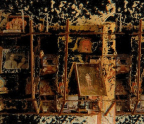In the Process of Making Themselves: Poster Art, Internationalism and the Cuban Revolution

“From a spark a fire will flare up.”
—motto of Iskra
I’m in the musty basement of the Marx Memorial Library and Workers’ School in London, UK. I find Marianna amongst piles of posters—she is the volunteer responsible for digitizing the library’s vast archive of posters. I am taken to a small office where Lenin spent two years, while in exile, writing for Iskra (“spark”), the underground newspaper and ideological heart of the Russian Social Democratic Labour Party.
About Iskra, Lenin had said, “A newspaper is not only a collective propagandist and a collective agitator, it is also a collective organizer. Political agitation is impossible without a regular and widely distributed newspaper. Its contributions and distributors formed the nucleus of the future Party.” There is a framed map on the wall with red arrows detailing the distribution of the paper throughout Russia and Europe—a reminder of the many lives that were risked so that this publication could find its readers.
I look at the tome on the small desk. It collects the old Iskra issues. I am visually jarred by the tightly packed pages of Cyrillic text. The frugality of space reads like a testament to the extremely difficult material and political conditions under which the publication was produced. It’s as if the feat of reading it is as great as that of producing it.
But I did not come here for Lenin. I came to look through the archive’s collection of posters and publications produced by the Organization of Solidarity with the People of Asia, Africa, and Latin America (OSPAAAL).
In January 1966, the Cuban people hosted the Tricontinental, a conference in Havana of revolutionary movements from Africa, Asia and Latin America. This historic meeting—with over 500 delegates and 200 observers from 82 countries on three continents—was born out of two anti-colonial formations: the more conciliatory Non-Aligned Movement (NAM), and the more radical Afro-Asian People’s Solidarity Organization (AAPSO). Hosting the conference in Havana solidified
You’re reading a preview, subscribe to read more.
Start your free 30 days





